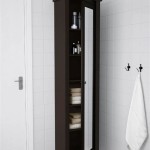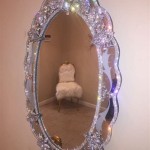Hanging a Mirror Without a Frame: A Guide to Achieving the Perfect Look
Mirrors can enhance a room's visual appeal and create an illusion of spaciousness. While framed mirrors are popular, frameless mirrors offer a contemporary and minimalist aesthetic, allowing the reflection to take center stage. However, hanging a frameless mirror presents a unique challenge: securing it without the support of a frame. This guide provides detailed instructions and tips on how to hang a mirror without a frame, ensuring a secure and aesthetically pleasing installation.
Choosing the Right Hanging Method
The first step in hanging a frameless mirror is selecting the appropriate hanging method. This decision depends on the mirror's weight, wall material, and desired aesthetic. For lightweight mirrors, adhesive tape is often sufficient. However, heavier mirrors require more robust solutions like mounting brackets or specialized hooks. Here are some common methods:
1. Adhesive Tape:
Adhesive tape is a quick and convenient option for lightweight mirrors, but it should be used with caution. Ensure the tape is specifically designed for heavy objects and apply it generously across the entire back of the mirror. This method is best suited for small, thin mirrors and may not be suitable for walls with textured surfaces.
2. Mounting Brackets:
Mounting brackets offer a secure and reliable solution for heavier mirrors. These brackets usually consist of two parts: a plate that attaches to the wall and a hook that attaches to the mirror's back. Choose brackets specifically designed for mirrors and ensure they have sufficient weight capacity.
3. D-Rings and Wire:
D-rings and wire are a traditional method for hanging framed artwork, but they can also work for frameless mirrors. Attach D-rings to the back of the mirror using screws or adhesive. Then, thread a wire through the D-rings and hang the mirror on a hook. This method provides flexibility in adjusting the mirror's height.
Preparing the Mirror and Wall
Before proceeding with the hanging process, take the necessary steps to prepare the mirror and wall. This ensures a smooth and secure installation.
1. Clean the Wall and Mirror:
Wipe down the wall and the back of the mirror with a clean cloth to remove any dust or debris. This will ensure that the adhesive tape or brackets adhere properly to the surface.
2. Locate the Studs:
If using mounting brackets, it is crucial to find the studs in the wall for maximum support. Use a stud finder to identify the studs and mark their positions. If hanging a heavier mirror, consider using multiple mounting points for added security.
3. Measure and Mark:
Measure the height and width of the mirror and determine the desired location on the wall. Use a pencil to mark the center point of the mirror on the wall. This serves as a reference for aligning the brackets or tape.
Hanging the Mirror
Once the preparation is complete, you can begin the hanging process. Follow these steps carefully to ensure a secure and aesthetically pleasing installation.
1. Install the Brackets:
If using mounting brackets, attach the wall plate to the wall using screws. Make sure the plate is level using a level tool. Then, attach the mirror hooks to the back of the mirror, aligning them with the wall plate. Carefully hang the mirror onto the hooks.
2. Apply Adhesive Tape:
If using adhesive tape, apply the tape evenly along the entire back of the mirror. Ensure the tape is securely adhered before pressing the mirror onto the wall. It is recommended to use several strips of tape for added support, especially for larger mirrors.
3. Hang with D-Rings and Wire:
If using D-rings and wire, attach the D-rings to the back of the mirror using screws or adhesive. Ensure the rings are securely fastened and level. Thread the wire through the D-rings and hang the mirror on a hook. Adjust the wire's length to achieve the desired height.
Tips for Success
Here are some additional tips to improve the effectiveness of hanging a frameless mirror:
1. Use a Level:
Utilize a level tool to ensure the mirror is hung straight and level with the wall. This avoids any visual imbalances and creates a more pleasing aesthetic.
2. Add a Protective Layer:
Consider placing a protective layer behind the mirror, such as a piece of cardboard or felt, to prevent scratches or damage to the wall. This is especially important for mirrors that are frequently moved.
3. Use a Helper:
Hanging a frameless mirror can be challenging, especially for larger or heavier mirrors. Consider enlisting the help of a friend or family member to provide support and assistance.
By following these guidelines, you can confidently hang a frameless mirror, creating a stylish and functional focal point in any room.

How To Install A Mirror Without Frame Merrypad

How To Hang A Frameless Mirror On The Wall With Pictures

How To Hang A Frameless Mirror On The Wall With Pictures

How To Hang A Heavy Mirror Lowe S

How To Install A Mirror Without Frame Merrypad

How To Install A Mirror Without Frame Merrypad

How To Hang A Heavy Mirror Lowe S

Easy For Hanging Mirrors And Frames Perfectly Every Time

How To Hang A Frameless Mirror On Wall E Architect

How To Hang A Mirror On Tile Wall Remington Avenue








